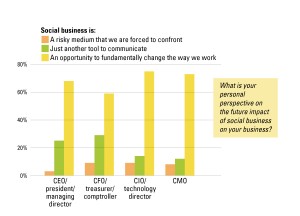A Deloitte and MIT Sloan Management Review report indicates that 70% of organizations surveyed believe that becoming a social business has potential to improve the way the overall business runs. Allow me to point out the obvious. This statement does not limit the benefits of being a social business to improved marketing.
To give you a preview of my session on social business at LEARN, the virtual event for digital marketing (November 11-22, 2013), I broke down the five must-have characteristics for a social business. While I understand that becoming a social business is a journey, each of these five characteristics must be in place at some level to be considered a social business. Let’s look at each one.
1. C-Suite Commitment
In a social business the top level executives embrace the culture and technology of being social. The C suite understands that the people who make up the organization already engage with friends, family and business colleagues in social media. And, rather than trying to prevent or limit employee engagement in social media channels, the organization embraces it in a way that aligns with its business objectives. It recognizes and embraces the power of employees being a “brand” through social engagement. The executives in a social business are transparent. They participate at some level of digital engagement through content contribution or internal social collaboration exhibiting an accessible human demeanor. This leads to a natural use of digital social engagement across at least three functional groups of the organization: 1) human resources, 2) customer service, 3) marketing. Ideally, the Sales organization also embraces social, especially when an organization invests in social business technology empowering sales people to collaborate with all corners of the organization to achieve sales objectives. In fact social selling is one of the fastest growing aspects of social business.
2. Marketing is Not a Department
A social business understands that content is the currency which fuels marketing success. And, content is best originated from subject matter experts spread throughout the organization. I’ve often said that no marketing department is big enough to staff subject matter experts. In a social business the role of the CMO is threefold: 1) Diplomat, 2) Analyst, 3) Marketer. The CMO should be a vision-caster, evangelizing the vision of the organization across all employees in order to inspire subject matter experts to avail themselves to contribute to the organization’s content marketing efforts. The role of the marketing department is to “produce” content by interviewing SMEs. The marketing team is transformed into journalists, interviewing SMEs, converting knowledge in their heads into engaging content in various formats spanning video, short and long form narrative as well as infographics and podcasts.
3. Employee Branding
When an organization understands the concept that “marketing is not a department” it naturally embraces employee branding. The notion that employees who build their personal brand might leave their employer is largely a myth. The opposite is true. Provide employees an opportunity to build their brand around their subject matter expertise and you will gain a loyal employee. Additionally, the employee’s brand reflects well on the corporate brand. I call this the halo effect in personal branding. A social business intentionally aligns with select employees to achieve this benefit. When you consider the impact of engaging content on a brand, employee contribution to content marketing is very powerful. Organizations large and small can achieve great results through employee branding.
4. Investment in Social Technology
If being a social business improves the overall performance of an organization, it’s only logical that investment in social technology is a necessity. Social technology allows a business to facilitate internal and external social engagement, development of content, social sharing, analysis and measurement of outcomes. In recent years, there has been approximately $30 billion spent in acquisitions of social technology vendors by companies such as Microsoft, Oracle, Salesforce and IBM, among others. These acquisitions are evidence that enterprise software companies want to participate in the growing demand for social technology used to enable their customer’s social business.
5. Data-driven Marketing
A social business eats data for breakfast, lunch and dinner. Data is used to understand the make-up of its employees, partners, competitors and customers. As referenced in the previous point, social technology can be used to gain valuable insights and intelligence for decision making purposes. Since we live in the age of relevance, data is a necessity to create content that is engaging to the intended audience. Whether we’re marketing to prospective customers or engaging with employees or partners, communicating in hyper relevant ways is absolutely necessary. Data analysis arms any business with decision enabling to create valuable customer experiences across all customer facing parts of an organization.
Data driven marketing also refers to analysis of customer sentiment and response to marketing programs. A social business understands the necessity of making this investment in order to make data driven decisions on all its marketing programs.
Relatively speaking, few organizations have made the paradigm shift or understand social business. Sure, many have invested in social business tools and technology. But, the culture change is a bigger paradigm shift than allocating budget for social business software. A social business is a journey. On average, it can take three years to reach maturity as a social business with strong executive support. The benefits are very worthwhile.
Learn how to make the transition from social media to social business
Join me this November at LEARN, the virtual event for digital marketing. During my session, Going from Social Media to Social Business, I will explain how to make the leap from tactical use of social media to strategic social business outcomes.
Event Date: November 11-22, 2013 | Location: Virtual | Register now!
